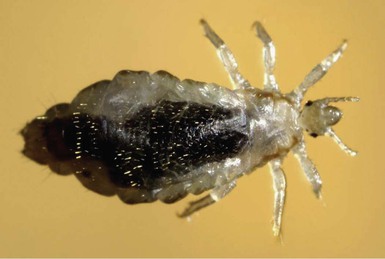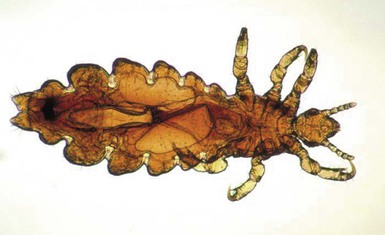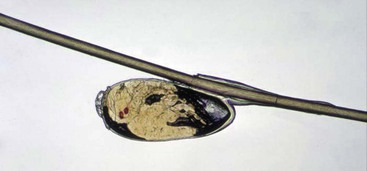James H. Diaz
Lice (Pediculosis)
Pediculosis is a complex of three different human infestations with two species of bloodsucking lice of the insect order Phthiraptera, suborder Anoplura: (1) Pediculus humanus and (2) Phthirus pubis. Sometime after early humans began to wear clothes, P. humanus evolved into two clinically distinct ectoparasitic variants, P. humanus var. corporis, the body louse (Fig. 294-1), and P. humanus var. capitis, the head louse (Fig. 294-2). Although morphologically indistinct, these human louse variants do not interbreed, prefer unique anatomic niches on human hosts, and are now considered distinct species. Specifically, head lice (P. humanus capitis) leave their hair shaft nests for blood meals on the scalp and body lice (P. humanus corporis) leave their clothes seams nests for blood meals on the body. Phthirus pubis, the crab or pubic louse (Fig. 294-3), is morphologically distinct from the two P. humanus species, has a crab-shaped body, and prefers to dwell in the hair-bearing areas of the pubic and inguinal areas but may also infest the hairy areas of the axillae, chest, and abdomen and even the eyelashes (phthiriasis palpebrum). Pubic lice remain relatively stationary, unless mating or egg-laying, anchored to the bases of hair shafts while blood feeding.
Epidemiology
Pediculosis capitis, or head lice, is the most common of the three types of human pediculoses, afflicting millions of people annually, mostly school-aged children, in both developing and industrialized nations. Body lice infestations, or pediculosis corporis, are associated with poor hygiene and low socioeconomic status and occur primarily in the indigent, institutionalized, homeless, refugees from civil unrest, and the immunocompromised. Body and head lice are usually transmitted by direct body or head-to-head contact or sharing headwear between infested individuals and, much less commonly, by indirect contact with fomites, such as bedding, clothing, towels, headgear, combs, and brushes. Pubic lice infestations, or phthiriasis, are caused by P. pubis, the pubic or crab louse. Pubic lice are more often transmitted during sexual rather than fomite contacts and often coexist with crusted (Norwegian) genital scabies and other sexually transmitted diseases.
Unlike head lice and pubic lice, body lice can transmit several bacterial diseases. Homeless, immunocompromised, and refugee populations are at greatest risk for body lice infestations and epidemics of body louse–borne bacterial diseases, including the following: (1) relapsing fever caused by Borrelia recurrentis, (2) trench fever caused by Bartonella quintana, and (3) epidemic typhus caused by Rickettsia prowazekii. Body lice have been recognized as infectious organisms of high importance, not only in displaced populations in evacuee and refugee camps but also in immunocompromised subjects, particularly homeless individuals with the acquired immunodeficiency syndrome (AIDS).1–3 B. quintana has now been isolated in head lice as well as body lice from homeless persons in the United States, establishing the potential for transmission of trench fever by blood-feeding head lice in addition to body lice.4
Diagnosis
Lice infestations are diagnosed by demonstrating live adult lice, nymphs, and viable eggs, or nits, in their precise human ecologic niches. Adult lice are flattened dorsoventrally and are 1 mm (pubic lice) to 3 mm (head and body lice) in length, have three pairs of legs ending in powerful claws that can grip hair shafts, and exhibit a reddish-brown hue after blood feeding (see Figs. 294-2 and 294-3). Females can live on their hosts for up to 3 months, lay up to 300 nits in a lifetime, and die within 24 hours when separated from hosts (see Fig. 294-2). Nits are oval, less than 1 mm in diameter, and grayish white (Fig. 294-4); they fluoresce in ultraviolet or Wood’s light when viable. Nits are deposited on hair shafts at the skin surface and hatch nymphs within 6 to 10 days (see Fig. 294-4). Nymphs resemble miniature adults and grow to adulthood within 10 days. Empty egg cases remain attached to hair shafts after hatching and are not diagnostic of active infection.5 Head lice and their viable nits are often attached to hairs close to the scalp, especially in occipital and postauricular locations. Because body lice visit their human hosts only to feed on blood, adults, nymphs, and nits are found in clothing, usually aligned along inner seams (Fig. 294-5). Pubic lice and their nits may be found in the pubic, perianal, and inguinal areas, in axillary and chest hair, and even in the eyelashes (phthiriasis palpebrum), especially in children who acquire pubic lice infestations from their parents (Fig. 294-6).6














